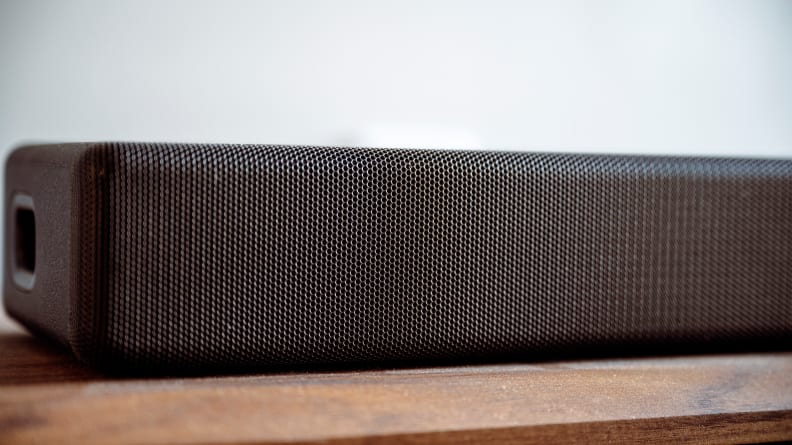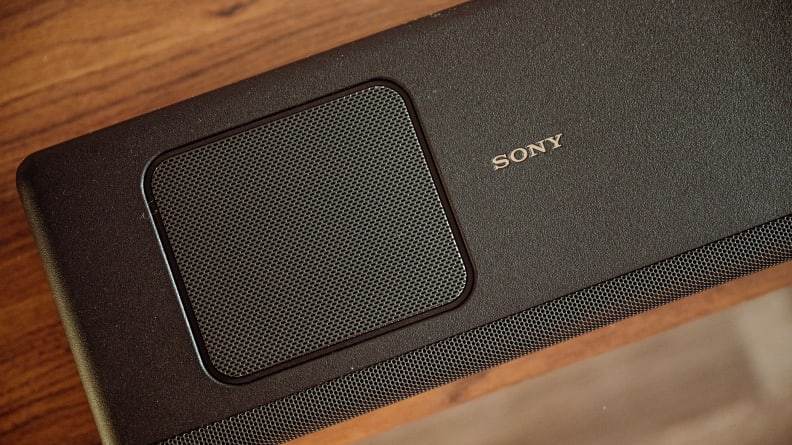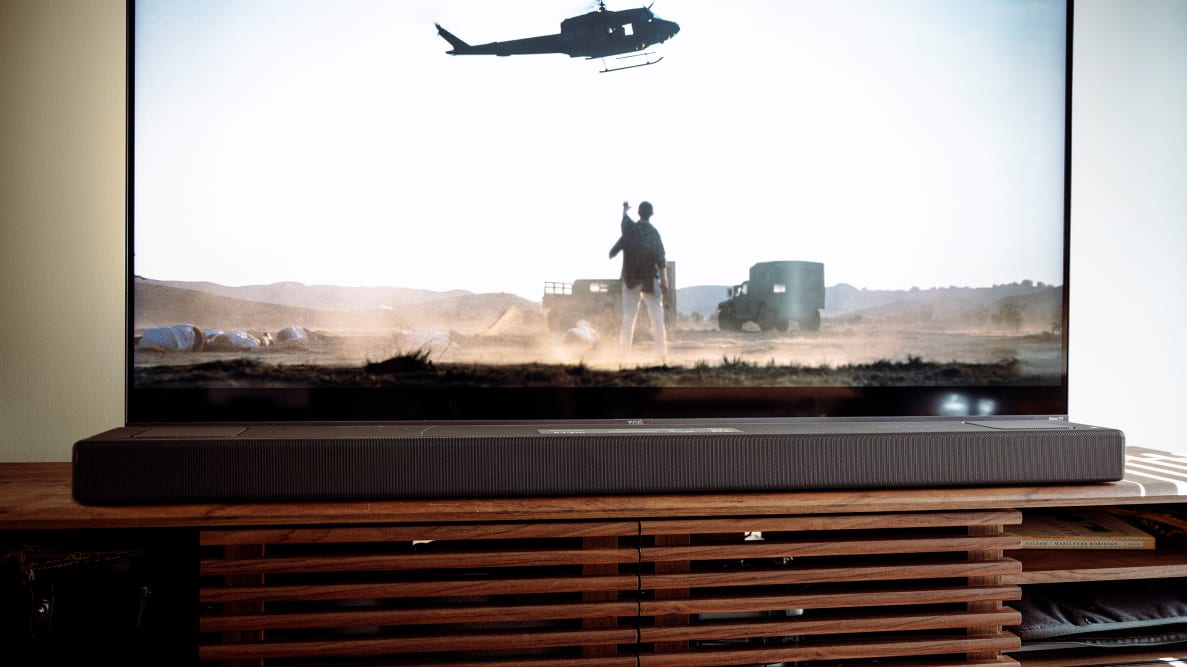Pros
-
Clear, immersive sound
-
Loaded with A/V features
-
Upgradable
Cons
-
Requires a learning curve
-
No viable app or EQ
Dolby Atmos soundbar shopping has been … odd as of late. The Arc, a relative deal at its $800 launch price, got jacked up to $899 when the supply chain went silly. At that price it’s not quite a bargain, but still impressive enough that we named it the best soundbar all around. Bose’s flagship Smart Soundbar 900 also costs $900, and as the market changes, that seems to be something of a new standard.
The $1,000 HT-A5000 competes well with those models in a lot of areas, offering plenty of streaming options like Spotify Connect and AirPlay 2, the ability to add surround speakers and a wireless subwoofer later on, and upfiring drivers for immersive Dolby Atmos sound. But, Sony being Sony, the A5000 is more of a traditional device, trading some of the convenience Sonos and Bose offer for A/V features like hi-res audio support and a spare HDMI port with 4K/120Hz passthrough. It’s not quite the everyman soundbar, but it’s a great option for gamers and A/V enthusiasts alike.
About the HT-A5000

The soundbar is quite wide, but its slim design means it shouldn't block most TV screens.
Here are the HT-A5000’s main specs:
- Height x Width x Depth: 2.75 x 47.75 x 5.625 inches
- Weight: 13 pounds 8 ounces
- Speaker channels: 5.1.2 configuration, 9 discrete channels including built-in woofers, dual upfiring speakers, and left/center/right channels (subwoofer and surround speakers available for purchase)
- Amplification: 450 watts peak power
- Wireless connection: Wi-Fi, Spotify Connect, AirPlay 2, Chromecast, Bluetooth 5.0
- Wired connection: HDMI ARC/eARC out, HDMI in (1), digital optical, analog, USB
- Smart features: Alexa and Google Assistant support (requires added speaker)
- Sound formats: Dolby Digital, Dolby Digital Plus, Dolby TrueHD, Dolby Atmos, Dolby Dual mono, DTS, DTS-HD High Resolution Audio, DTS-HD Master Audio, DTS ES, DTS 96/24, DTS:X, LPCM, DSD, Wav, Flac, ALAC(.m4a, .mov), AIFF(.aiff, .aif), HE AAC, AAC, mp3, Monkey Audio, WMA, Ogg Vorbis
- Video support: 4K/HDR passthrough at 120Hz (includes Dolby Vision), 8K passthrough
The A5000 is very reminiscent of its pricier sibling, with similar dimensions and design. Though it’s a few inches shorter and nearly six pounds lighter than the A7000, that’s not to say it’s a compact bar by any means. Pulling it from the package, it’s clear this is still a monster-sized unit that requires a large TV console to support its breadth. At just under three inches tall, though, it should fit well beneath most TVs, mounted or otherwise. It’s immediately evident the A5000 isn’t as posh as Sony's flagship bar, skipping some of the luxury touches for a decidedly boring, black-plastic exterior.
In the box, you’ll find all you need to get started, including HDMI, and power cables (there’s no optical, but you’ll need to connect via HDMI ARC or eARC for Dolby Atmos anyway), mounting brackets, a large instruction booklet, and a boxy remote loaded with rubberized keys.
What we like
Clear and immersive sound

Dolby Atmos and virtual surround sound performance are among the top in its class.
You’re probably not buying a soundbar for its lovely aesthetics but to punch up your paltry TV audio, and you won’t go wrong when you choose Sony as your guide. The A5000 is a powerful machine that offers plenty of clarity in the midrange and treble regions, and even some impressive juice in the upper and mid-bass. As single-piece Dolby Atmos systems go, you’ll have a hard time beating its performance for the money, and adding on Sony’s surrounds and subwoofer can take things even further.
The A5000’s touch is a bit lighter and flintier in the upper midrange than Sony’s A7000, or the Sonos Arc for that matter. It’s much more powerful and forceful than Bose’s Smart Soundbar 900, but it isn’t quite as plush in the details as that bar either. Overall, though, this is an impressive package. While it’s not going to knock your socks off in regular TV fare like sitcoms or news broadcasts, it’s a massive improvement over TV audio and offers some pleasant detail in the subtleties.
Feed it something bolder like a Dolby Atmos-supported movie or TV show, and the bar rises to the occasion with aplomb, especially once you’ve gone through its traditional A/V setup that includes the option to tune each speaker separately or auto-calibrate it to your room.
One thing you’ll want to do right away for most content (and one reason this bar demands more direct attention than more intuitive options like the Arc) is to make sure you’ve engaged the Sound Field Optimizer via the remote. This expands the A5000’s virtual soundstage by leaps and bounds, and strangely, isn’t automatically engaged when met with Dolby Atmos or surround sound content. Going through my favorite Atmos demos, I was blown away by the difference with the Optimizer on and off, massively expanding the soundstage or utterly collapsing it respectively.
I had a similarly impressive experience with the A5000 as with the A7000 when it comes to the ability to bounce sonic imaging around the room. The “Amaze” Atmos demo (my favorite) was rendered with enthralling immersion, from the booming thunder to the soothing rain overhead to the collage of nighttime insects that seems to tickle your brain stem and virtually transport you into a Georgia swamp. While the A5000 isn’t quite as magical (or as powerful) as its sibling, it gets you most of the way there, and at a much lower cost.
Another standby Atmos testing ground, Ant-Man, was equally engaging. While turning on the Sound Field does pinch things a bit in the upper midrange and treble, the sound falls short of overly sibilant, and the lighter touch is well worth it. The water scene in the shower as Scott takes his first ride in the Ant-Man suit is utterly immersive, while the epic battle against Yellowjacket, which includes the brilliant micro-ride in a briefcase falling from a helicopter, is incredibly cinematic.
The bar does well with music too, though it’s less organic than the Sonos Arc there, and less articulate than the A7000. Again, the Sound Field button is key, making stereo music sound much more natural while off, though your ears will take a moment to adjust to the more confined soundstage. When you play your boomiest electronic or hip-hop tracks, you’ll note the bar falls shy of full, deep bass in the lowest registers. For seriously low frequencies to properly register you’ll need to connect one of Sony’s separate subs. Still, the A5000 does well for a single bar.
Sony also wants you to know that its impressive sound field tech works well when adding surrounds. The idea is you don’t need to put the speakers directly even, so they’re easy to place in any room and will sound well matched, and you can easily adjust the balance from the remote. It’s a neat trick, but still a pricey one as Sony surround speakers start at $350.
Next-gen connectivity
One of the biggest arguments for spending a little more on something like the HT-A5000 is its spare HDMI input. It doesn’t have a two-shot like the A7000, but it does claim support for 4K video passthrough at 120Hz. While I wasn’t able to test that directly (again, thanks to the supply chain), the specs mean you should be able to connect a next-gen console (PS5 or Xbox Series X) with full playback support, saving you a precious HDMI input on your next-gen TV.
The bar also includes HDMI eARC, of course, which allows you to transfer full-resolution Dolby Atmos downstream from any device connected to your next-gen TV (as long as it too has eARC). There’s also an optical input, and even a USB port that allows for playback of virtually any high-resolution audio files.
Hi-res audio, Dolby Atmos, DTS:X, and 360 Reality Audio
If there’s a 3D audio format or high-resolution audio format you want to use, chances are Sony’s bar supports it. That goes for just about any audio file they’ve got a name for, the aforementioned Dolby Atmos, DTS:X for A/V nerds with a large Blu-ray or Vudu film collection, and of course, Sony’s own 360 Reality Audio format.
Plenty of other great features
To go alongside its excellent connectivity and sound format options, the bar is loaded with nearly every feature you could want. That includes features like Chromecast, Spotify Connect, and AirPlay 2 Wi-Fi streaming support, as well as Bluetooth streaming. It even has the ability to connect Bluetooth headphones, which could come in handy for those with young kids. There are also a few handy sound modes on the remote, including a speech enhancement mode and Night Mode (though, oddly for Sony, there’s no notable form of EQ available).
You’ll get a traditional on-screen interface for controlling all settings and firmware updates (though that’s in place of a more modern app), and a full-scale traditional remote, something Sonos soundbars don’t offer. And while you can’t connect the bar in a multi-room audio system throughout the home, as mentioned above, you can connect your choice of two Sony surround sound speaker sets and two subwoofers (for a fee of course).
What we don’t like
Plain Jane design

The A5000's visual design is nothing to write home about.
This isn’t something that should put most buyers on the fence, but it should be noted that this bar is visually among the most boring of its kind. The exterior is hard plastic and a traditional mesh grille, with none of the lux touchpoints of the A7000 like glass cover plates. It’s got no Swedish flair like the Sonos Arc, and it’s certainly not as pretty as the Bose 900, either. Like cheap soundbars, this hunk of mega-plastic is designed to simply blend in.
Not especially user friendly
While the system isn’t overly complex, it will take a bit of effort for soundbar novices. Unlike the Sonos Arc, which is designed to almost take over the operation completely, the A5000 requires you to walk through on-screen steps for setup by tapping the Home button and finding it in your TV’s A/V inputs. It’s not exactly a MENSA test, and each step is relatively simple to complete, but if you’re new to audio devices, there’s a learning curve.
You’ll also need to be conscious of which input you’re using and (gasp) manually switch them in most cases—which means you’ll need to keep the included remote nearby, even though you can control power and volume with your TV remote. I also had a few moments when the bar did not turn on automatically with the TV, as something was lost in translation between the two devices. None of these are deal breakers, but they’re worth keeping in mind.
No app or EQ
In the same usability vein, there’s no real control app for the HT-A5000 like you’ll get with Sonos and Bose soundbars. Such apps can be very convenient for controlling the system from your phone, especially if you don’t want to disrupt what you’re watching and go to a dedicated Home screen. And again, there’s also no real EQ available here. I didn’t find the need for one especially, but if you find the treble a bit too sharp, for instance, you have no options.
You can control the volume of individual channels in the main settings, but it’s a bit of a thing to engage manual setup and you may find going with the calibrated option sounds better anyway. There’s also no built-in voice assistant—you’ll need a separate speaker—but for those concerned about privacy this may actually be a plus. And simply having a dedicated remote and keys for adjusting the subwoofer and surrounds (should you add them) is a nice addition Sonos can’t offer.
Should you buy it?
Yes, especially if you’re a gamer or A/V enthusiast

The A5000 is an excellent Dolby Atmos bar for A/V enthusiasts and gamers.
Sony’s HT-A5000 isn’t cheap, but it’s a much more affordable proposition than the brand’s HT-A7000, and offers a large hunk of what makes that bar so great. You’ll get clear and expansive sound, good Dolby Atmos performance, tons of A/V features (especially compared to Sonos and Bose), and support for just about every hi-res audio file there is. If you’re willing to spend a bit more and put in a bit of effort, the A5000 rewards you with excellent performance and features, especially optimized for those with outboard video or gaming devices.
If you need something more user-friendly, or if you want features like a built-in voice assistant or multi-room audio support, you’ll want to consider the cheaper Sonos Arc as your best alternative. Just keep in mind it won’t offer the same A/V support, excluding features like hi-res audio, HDMI input, and even its own remote. Alternatively, the Vizio Elevate soundbar costs about the same as the HT-A5000, and comes with wired surround speakers, a separate sub, and similar A/V features (but not 4K/120Hz passthrough). It’s also less compact, without the same option to use it as a singular bar.
For the right buyer, Sony’s HT-A5000 offers a ton of value and performance packed into a single bar that sounds a lot better than you’d expect. Especially if you’re a gamer or A/V nerd looking for a relatively compact home theater option, Sony’s HT-A5000 is a great choice.
Meet the tester
Hailing originally from Montana, Ryan parlayed his time working as a musician and audio engineer into a career in digital media in 2012. Since then he's had extensive experience as a writer and editor, including everything from op-eds and features to reviews on TVs, audio gear, smart home devices, and more.
Checking our work.
Our team is here to help you buy the best stuff and love what you own. Our writers, editors, and experts obsess over the products we cover to make sure you're confident and satisfied. Have a different opinion about something we recommend? Email us and we'll compare notes.
Shoot us an email



